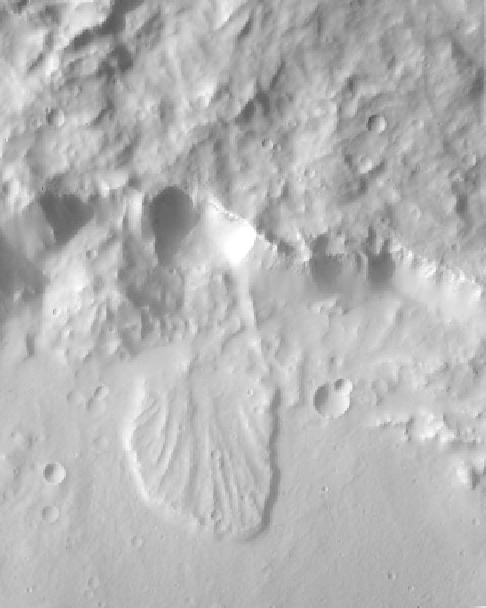Geology Reference
In-Depth Information
Figure 7.20. This small landslide found on the inner wall of an impact
crater is typical of many such features where slopes are steep; the
area shown is 17 km by 20 km (NASA THEMIS orbit 27216).
suggested by linear scarps roughly parallel with the frac-
tures in the main canyon system, the primary formational
process was mass wasting on a grand scale.
Figure 7.21. MOC images of
(arrows) that
formed between August 1999 (top image) and April 2001 (bottom
image) in terrain north of Olympus Mons; the area shown is 3 km by
3.5 km (NASA PIA03226).
“
dark slope streaks
”
7.5.5 Gradation features
Like Earth, Mars exhibits a rich history of gradation
involving wind, water, mass wasting, and periglacial pro-
cesses. Mass wasting has enlarged the canyonlands, form-
ing huge scarps and landslides along the walls, and
generating the chaos terrain. The aureole deposits noted
above in association with the large shield volcanoes likely
involved mass wasting to form lahars.
Small landslides are ubiquitous onMars, especially along
over-steepened slopes, as on impact crater walls
(Fig. 7.20)
.
An active landslide was even
“
captured
”
in an image in
early 2008 that showed dust and huge blocks of rock falling
down a 700 m scarp. Some active mass wasting features,
called
“
dark slope streaks,
”
continue to form today
(Fig. 7.21)
. They represent exposure of dark materials
when bright dust or bring water slides downslope. These
features fade with time, as dust settles from the atmosphere
and mantles the dark substrate or as water evaporates.
Other
flow-like features seen on images are likely to be
glaciers
(Fig. 7.22)
, as suggested by Jim Head et al.
(
2010
) from their analysis of Mars Express data. Results
from the radar system on the MRO reveal the presence of
ice beneath many of the putative glacial features, even in
the lower latitudes closer to the equator.
The search for evidence of past and present water on
Mars, either as ice or in liquid form, is a fascinating story.
When the
first spacecraft images of Mars were returned in
the 1960s, Mars was thought to be a dry, Moon-like planet




